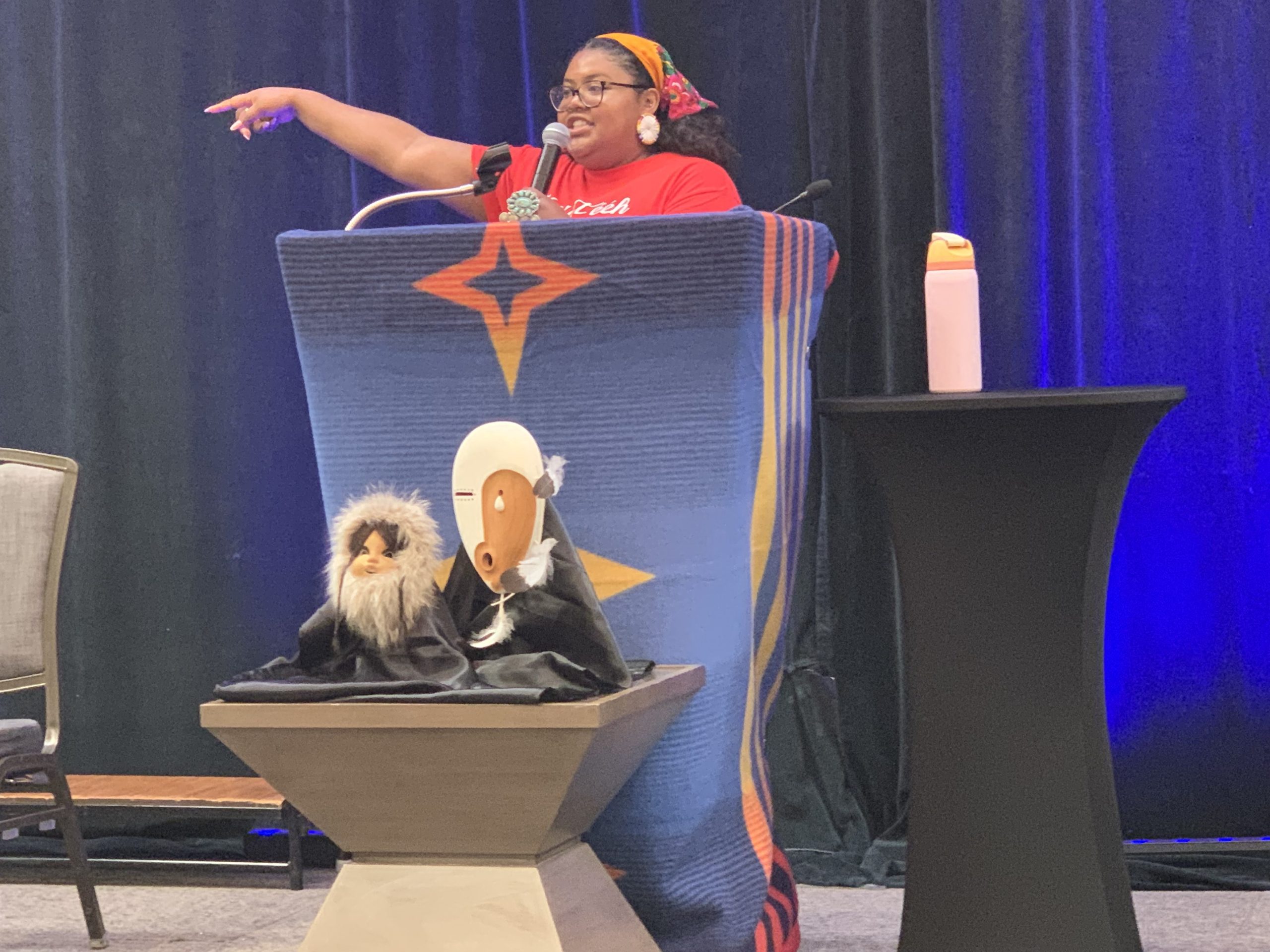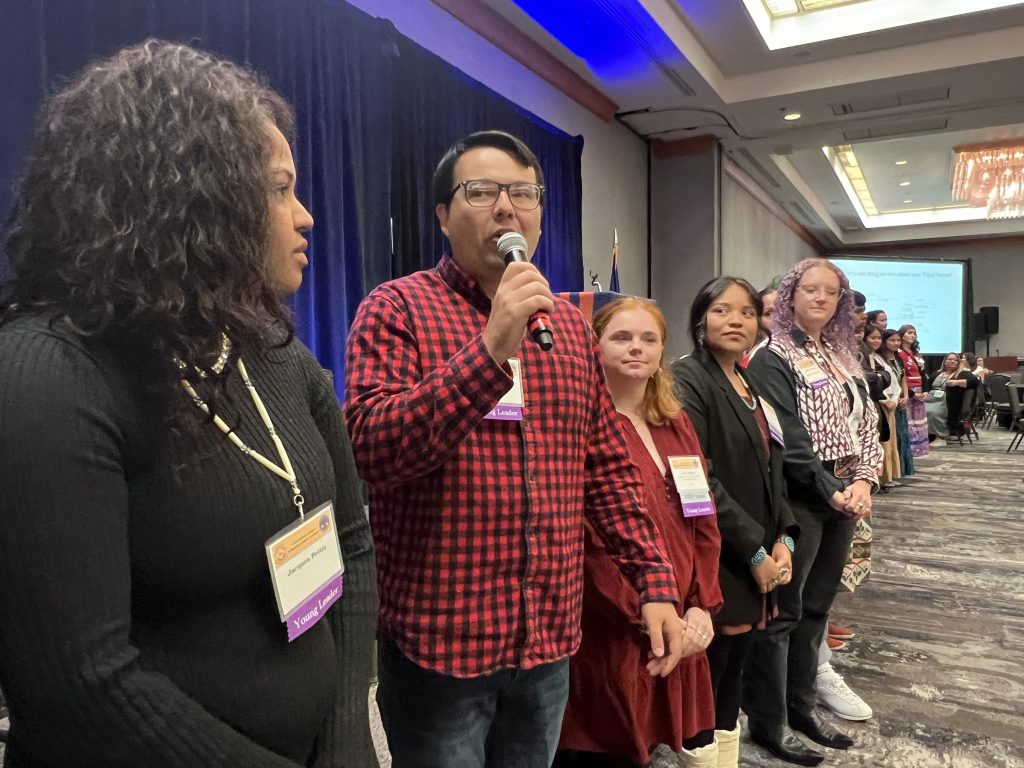Podcast: Play in new window | Download | Embed
Tribes and Indigenous groups from across the country met in Anchorage, Alaska last week for the Alaska National Tribal and Indigenous Climate Conference.
As KNBA’s Rhonda McBride tells us, young leaders were featured at the close of the gathering.
Throughout the conference there were serious conversations about floods, fires, erosion, and the deteriorating health of rivers and oceans.
For the young people who came, there is a sense of urgency due to the rapid amount of change that has coincided with a warming climate.
“My home is T’iis Nideeshghiiz.”
That’s the Navajo name for Newcomb, N.M.
It means cottonwood trees, which Kianna Pete, a Navajo neuroscience student, says are disappearing.
“Our ancestors named the land for a reason. But there is no cotton trees there. So what does that mean for the place name, if they’re no longer reflecting the land?

Summer Powell, who is from the Navajo Nation in Window Rock, Ariz., moderates the youth leaders panel. (Photo: Rhonda McBride)
Throughout the Southwest, rivers on traditional lands are dying.
Lakin Epaloose is an artist and educator who does work for the National Park Service at the Grand Canyon.
“There used to be a river that flowed through Zuni for thousands of years, but right now it’s dried up with in the last 50 years.”
Epaloose says his people once gardened with water from that river – and followed it to the Grand Canyon to gather medicinal plants. He says he took a sample of water from an Alaskan glacier to bring home – to remind him that all waters are connected.
Many of the young leaders at the conference like Mocha Reynolds (Lake Superior Ojibwe) called for Indigenous people to return to their traditional role as stewards of the land.
“We need be out there cultivating healthy forests, healthy rivers, healthy oceans, healthy lives. It’s so vital that we leave the colonial ways behind and return to the old ways.”
Young leaders say Indigenous peoples need to tap those traditional systems of caring for the land and spread the knowledge.

An illustration on the cover of the Oceti Sakowin Essential Understandings and Standards. (Courtesy South Dakota Department of Education)
A team recently proposed changes to South Dakota’s framework for Indigenous education, making the lessons more accessible for teachers across the state.
Kathleen Shannon has more.
The Oceti Sakowin Essential Understandings and Standards (OSEU) – in the works since 2008 – were approved by the state in 2018 for education about the region’s Indigenous cultures and ways of knowing.
Some of the core understandings are built on themes including environment, identity, kinship, traditions, and sovereignty.
According to the document, the framework offers not just an opportunity to learn about Indigenous people, but also from them.
Roberta Bizardie sits on the 2024 Revisioning and Reaffirming Team and says its meant to be imbued throughout an entire school day, rather than restricted to just social studies or history class.
“We want kids to understand when you walk in the door, we’re incorporating them throughout your whole day. And just to really help build up that identity side of who our kids are.”
According to a 2023 state survey, 62% of South Dakota educators reported using the OSEU standards, a 17% increase from 2021, though the response rate dropped.
There are no state requirements to implement the standards, though Bizardie says Todd County – where she’s superintendent – has a policy to ensure they’re used.
Public comment on the proposal ends September 16.


(Courtesy All Pueblo Council of Governors / Facebook)
The All Pueblo Council of Governors, which represents 19 Pueblos in New Mexico and one in Texas, has formally endorsed Vice President Kamala Harris for president and Minnesota Governor Tim Walz for vice president.
The council passed a Resolution on the endorsement during a recent monthly meeting.
According to the pueblo governors, they believe a Harris-Walz administration would recognize tribal sovereignty, address tribal needs, and support self-determination and the preservation of Indigenous languages and cultures.
They’ve issued a formal invitation to the candidates to engage with leadership, and meet with Pueblo people ahead of the November election.
Get National Native News delivered to your inbox daily and stay up-to-date on the 2024 Native Vote. Sign up for our daily newsletter today.



